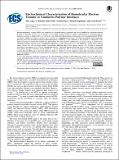| dc.contributor.author | Agee, Alec | |
| dc.contributor.author | Gill, Thomas Mark | |
| dc.contributor.author | Pace, Gordon | |
| dc.contributor.author | Segalman, Rachel | |
| dc.contributor.author | Furst, Ariel | |
| dc.date.accessioned | 2025-03-04T21:51:21Z | |
| dc.date.available | 2025-03-04T21:51:21Z | |
| dc.date.issued | 2023-01-01 | |
| dc.identifier.uri | https://hdl.handle.net/1721.1/158306 | |
| dc.description.abstract | Bio-electrochemical systems (BESs) are promising for renewable energy generation but remain hindered by inefficient electron transfer at electrode surfaces. As the toolbox of bio-anode materials increases, rigorous electrochemical characterization of emerging materials is needed. Here, we holistically characterize the electrochemical interaction of flavin mononucleotide (FMN), an electron shuttle in biological systems and a cofactor for oxidoreductase enzymes, with the bio-inspired mixed conducting polymer poly{3-[6'-(N-methylimidazolium)hexyl]thiophene} (P3HT-Im+). The behavior of this polymer is compared to the equivalent polymer without the histidine-like imidazolium. We find improved conductivity and charge storage in imidazolium-containing polymers beyond what is explained by differences in the electroactive area. The P3HT-Im+ further shows internal charge storage but with negligible faradaic contribution, indicating that charge storage capacity may translate to improved biocatalysis non-intuitive ways. Finally, one-electron transfer is observed between FMN and glassy carbon, while a bio-similar two-electron transfer is observed for the P3HT-Im+. To our knowledge, this is the first example of a concerted two-electron transfer between FMN and an electrode interface, which we attribute to the bio-inspired, histidine-like imidazolium functional groups in the polymer. These studies demonstrate the importance of bio-relevant materials characterization when such materials are deployed in BESs. | en_US |
| dc.language.iso | en | |
| dc.publisher | The Electrochemical Society | en_US |
| dc.relation.isversionof | 10.1149/1945-7111/acb239 | en_US |
| dc.rights | Creative Commons Attribution-NonCommercial-NoDerivatives | en_US |
| dc.rights.uri | https://creativecommons.org/licenses/by-nc-nd/4.0/ | en_US |
| dc.source | The Electrochemical Society | en_US |
| dc.title | Electrochemical Characterization of Biomolecular Electron Transfer at Conductive Polymer Interfaces | en_US |
| dc.type | Article | en_US |
| dc.identifier.citation | Alec Agee et al 2023 J. Electrochem. Soc. 170 016509 | en_US |
| dc.contributor.department | Massachusetts Institute of Technology. Department of Chemical Engineering | en_US |
| dc.relation.journal | Journal of The Electrochemical Society | en_US |
| dc.eprint.version | Final published version | en_US |
| dc.type.uri | http://purl.org/eprint/type/JournalArticle | en_US |
| eprint.status | http://purl.org/eprint/status/PeerReviewed | en_US |
| dc.date.updated | 2025-03-04T21:37:36Z | |
| dspace.orderedauthors | Agee, A; Gill, TM; Pace, G; Segalman, R; Furst, A | en_US |
| dspace.date.submission | 2025-03-04T21:37:38Z | |
| mit.journal.volume | 170 | en_US |
| mit.journal.issue | 1 | en_US |
| mit.license | PUBLISHER_CC | |
| mit.metadata.status | Authority Work and Publication Information Needed | en_US |
